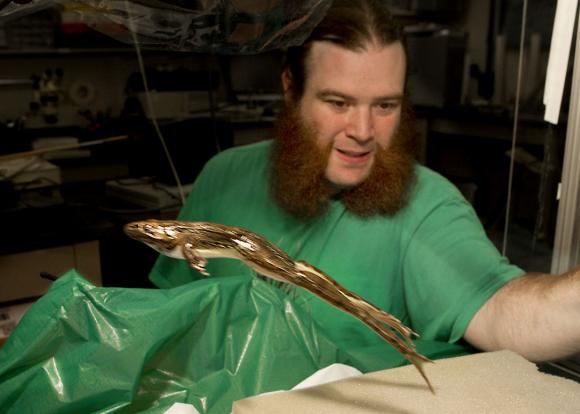PROVIDENCE, R.I. [Brown University] — Some species of frogs and many other animals are able to jump far beyond what appear to be their capabilities. The trained contestants in the frog-jumping competition in Calaveras County, Calif., come to mind, but even ordinary frogs can leap several times farther than their physiology would seem to allow.
“Muscles alone couldn’t produce jumps that good,” said Henry Astley, who studies the biomechanics of frog jumping at Brown University.
In a paper published in Biology Letters, Astley and Thomas Roberts, associate professor of biology, show that the key to frogs’ leaping lies in their stretchy tendons: Before jumping, the leg muscle shortens, loading energy into the tendon, which then recoils like a spring to propel the frog up, up and away. Even though as much as a quarter of a frog’s mass is in its legs, it would be physically incapable of jumping as far without the tendon’s services.
“In order to get truly exceptional jumping performance, you need some sort of elastic structure,” said Astley, a fourth-year graduate student in Roberts’s lab in the Department of Ecology and Evolutionary Biology.
Astley and Roberts examined jumps by the northern leopard frog (Rana pipiens), a pond frog common in the northeast United States. The pair implanted metal beads into the shin bone, ankle bone and leg muscle of four frogs and then recorded their leaps with 3-D X-ray video technology developed at Brown. The video, filmed at 500 frames per second and displaying the jump about 17 times slower than normal, tracks the changes in the leg muscle’s length and joint movement before, during and after a jump.
As the frog readies itself to leap, its calf muscle shortens. After about 100 milliseconds, the calf muscle stops moving, and the energy has been fully loaded into the stretched tendon. At the moment the frog jumps, the tendon, which wraps around the ankle bone, releases its energy, much like a catapult or archer’s bow, causing a very rapid extension of the ankle joint that propels the frog forward. The entire jump — from preparation to leap — lasts about a fifth of a second, the experiments showed. Other frog species jump much faster.
“It’s the first time we’ve really gotten the inner workings, that we’ve put all the pieces (to frog jumping) together,” Astley said. “We now have a clearer idea what’s going on.”
How the tendons, muscles and joints work in frog jumping may help explain how other animals are such head-scratching leapers — invertebrates like the humble flea or the grasshopper or vertebrates like guinea fowl and bush babies.
“Frogs are interesting in their own right, but we are also confident that this study gives us insight into how muscles and tendons work together in animal movement,” said Roberts. “Other studies have presented evidence for an elastic mechanism, but Henry's gives us the first glimpse of how it actually works.“
The National Science Foundation funded the research.

